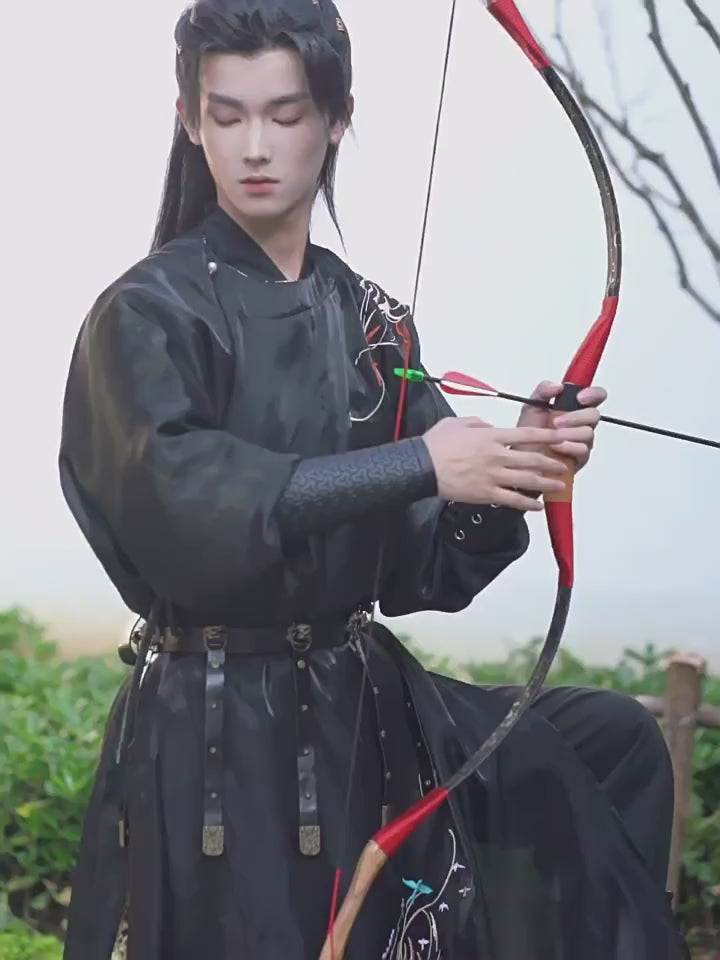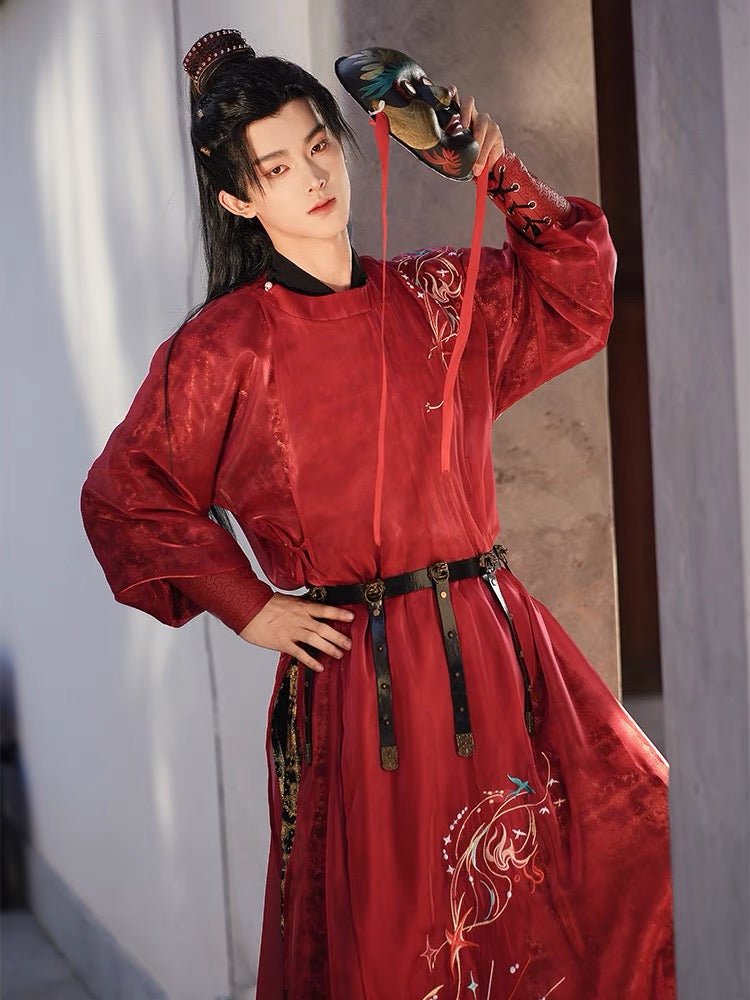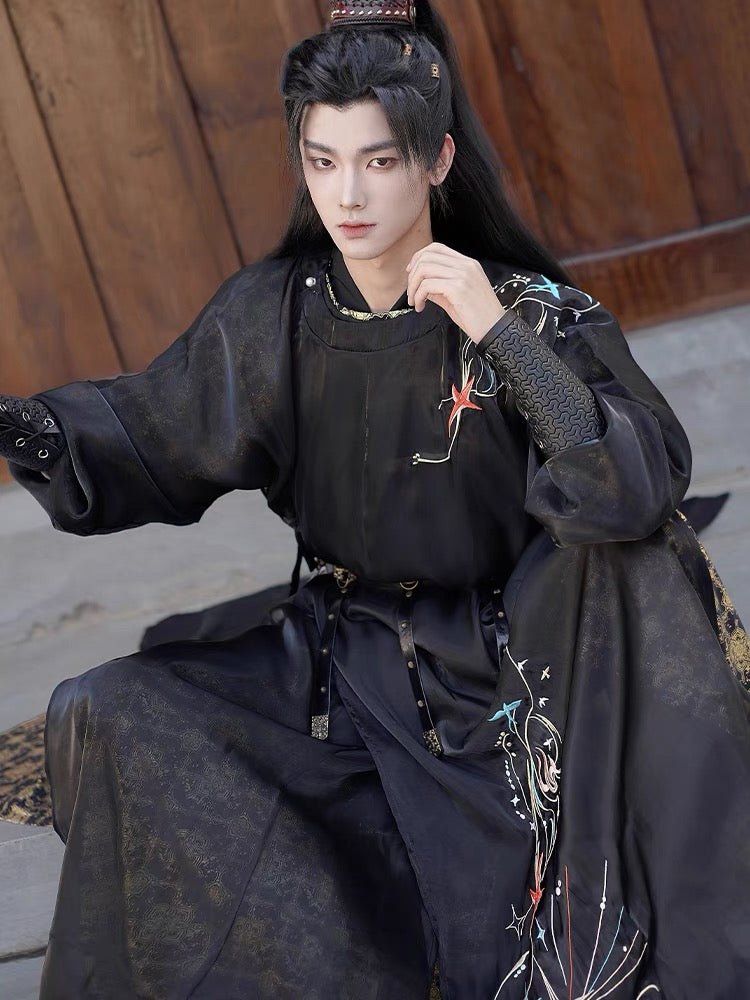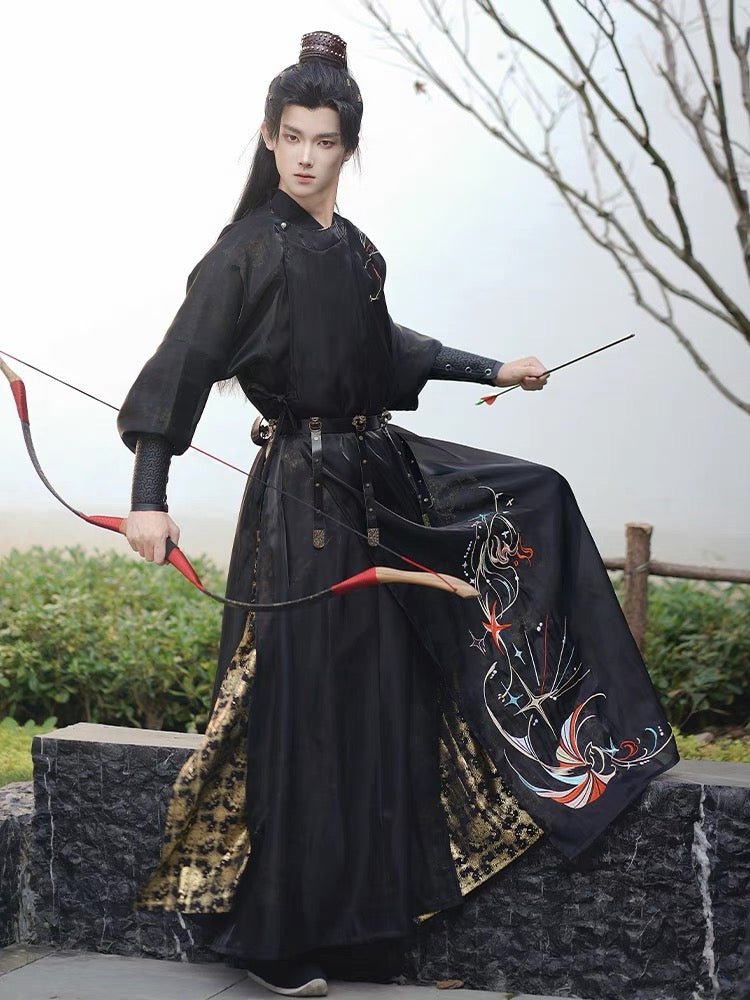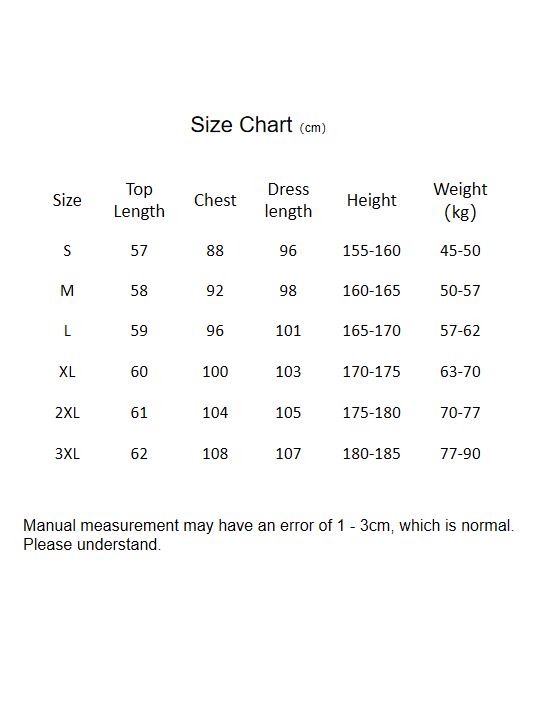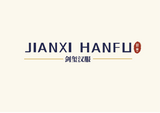The system of Tang Dynasty men's Hanfu (618-907 AD) was well-developed. It not only retained the traditional ritual attributes of Hanfu but also integrated practicality under the influence of Hu-style costumes (garments of non-Han ethnic groups)—a blend of elements that defined this iconic clothing style. Within the broader category of this traditional attire, there were three core styles, each serving distinct purposes and reflecting social hierarchies:
As the most prevalent style of Tang Dynasty men's Hanfu, the round-collar robe featured a closed round collar, with sleeve designs tailored to different needs and social roles. Narrow sleeves, influenced by Hu costumes, facilitated horseback riding, archery, and labor—making them popular among commoners and military personnel. Wide sleeves, by contrast, were worn daily by nobles and scholars, aligning with the elegant aesthetic of Tang-era men's Hanfu for elite groups.
The robe reached below the knees, with side slits for ease of movement—another practical detail that balanced functionality and tradition in this men’s attire. Fabrics varied sharply by social class: nobles used fine silk materials like ling (damask), luo (gauze), chou (satin), and duan (brocade), while commoners relied on coarse linen. A strict color hierarchy further distinguished ranks within Tang Dynasty men's Hanfu: purple robes for officials above Rank Three, crimson robes for those above Rank Five, and cyan robes for Rank Nine. Commoners mostly wore plain shades like white and gray. This hierarchical system is clearly recorded in The Old Book of Tang: Records of Costumes and Apparel.
Derived from traditional Hanfu long shirts, the Lan Shirt was a refined subset of Tang Dynasty men's Hanfu designed specifically as formal wear for scholars and students. It added a one-foot-wide horizontal band (lan) at the hem (usually in the same color or a lighter shade), symbolizing the ancient "upper garment + lower skirt" tradition that remained integral to Tang men’s Hanfu ceremonial designs.
True to the dignified demeanor of scholars, this style typically had wide sleeves, with fabrics ranging from fine cloth to thin silk. Colors tended to be plain (e.g., white, light cyan), and it was always paired with a waist belt—emphasizing the modesty and elegance expected of scholarly attire in the Tang era.
No set of Tang Dynasty men's Hanfu was complete without the Futou, its core matching headgear. Evolved from headscarves of the Eastern Han Dynasty (25-220 AD), the Futou adapted over time to become a defining accessory of this traditional men’s attire.
In the early Tang Dynasty, it was soft: made of silk cloth wrapped around the hair bun, with two ends hanging naturally—this style was common among both nobles and commoners in casual ensembles. After the mid-Tang period, "hard-foot futou" emerged: framed with iron wire or bamboo strips, its two ends could be straight or upturned (e.g., the "spreading-foot futou"). This sturdier design became an iconic symbol of official and noble Tang Dynasty men's Hanfu, while commoners continued to favor soft-foot futou for daily wear.

The design and use of Tang Dynasty men's Hanfu were shaped by three key principles:
-
Distinct hierarchical system: Colors, fabrics, and styles were tightly tied to social status—from purple official robes to linen commoner attire, clothing signaled rank at a glance.
-
Integration of Han and Hu elements: Features like narrow sleeves and side slits (borrowed from Hu costumes) blended seamlessly with traditional Hanfu silhouettes, reflecting the open cultural spirit of the Tang Dynasty in its men’s attire.
-
Balance of practicality and ritualism: This traditional clothing met daily activity needs (e.g., narrow sleeves for labor) while preserving the ceremonial function of Hanfu—embodying the era’s ability to merge utility with tradition.
This yuanlingpao (round-collar robe) is a classic form of men's Hanfu from the Tang Dynasty, meticulously crafted from fabric with excellent drape. The exquisite and elegant traditional patterns on the fabric endow the garment with a sense of three-dimensionality and shape, which can cleverly modify the figure — when worn, the figure appears taller, straighter, and more slender in proportion, as if "lengthened" ingeniously, fully showcasing a handsome and unrestrained bearing.
A major highlight of this garment is its layered design: it pairs with a black gold-foiled round collar robe as the inner layer, and a light gauze round collar robe is worn over it. When the breeze blows, the corners of the gauze outer robe flutter gently, revealing the shining gold-foiled patterns inside, instantly full of luxury and extremely eye-catching in visual effect. The outer gauze round collar robe is available in black and red. No matter which one is chosen, it perfectly integrates the authentic ancient charm of Tang-style clothing with practical wear, making owning such a Tang-style magnificent garment a preferred choice that combines texture and cost-effectiveness.
The gold-foiled round-collar robe inside is decorated with subtle patterns, seemingly interwoven with twisted-branch flowers and geometric motifs. The twisted-branch pattern symbolizes “endless vitality and continuity”, adding a mysterious and luxurious temperament to the whole. The outer gauze round collar robe is embroidered with the same series of agile patterns (such as totems combining flames and starbursts) on the shoulders and skirt, echoing the patterns of the inner garment. It not only enriches the layers but also makes the delicacy of the embroidery faintly visible in the hazy texture of the gauze, as if integrating the romance and nobility of the flourishing Tang Dynasty into the flowing sleeves.
To fully capture the essence of Tang Dynasty men's Hanfu, this round-collar robe pairs beautifully with several antique-style pieces:
- A plain white stand collar inner garment: its neckline adds subtle layers when exposed, echoing the layered silhouettes of traditional Tang men’s Hanfu.
- Wrist guards: these bring a touch of martial spirit, referencing the military and equestrian influences in some Tang-era styles.
- A waist belt: Opt for a double-button belt or a diéxiè belt (adorned with nine ornaments, which can hang small items like pouches—both practical and decorative, just like belts in historical Tang men’s attire).
- Hanfu boots: Neat, closed-toe boots complete the look, as footwear was a key detail in authentic Tang-era men’s ensembles.
- A wide-sleeved dàchǎng (outer robe): Draping this over the round-collar robe enhances the grandeur of the outfit, capturing the essence of formal Tang Dynasty men's Hanfu.
Wearing this ensemble feels like stepping back into Chang’an (the Tang capital) a thousand years ago. Its retro, eye-catching style stands out on the street—while staying true to the authenticity of Tang men’s traditional attire.
This set of clothes includes a gold - stenciled round - collar robe, a sheer round - collar robe, a belt, and wrist - guards.
Please note that the pattern print is not fixed, the position will be random and differ from the product images.
Fabric & Wash
Material: Polyester Recommend Hand-wash with your favorite mild detergent; Cold or warm water, maximum temperature 35°C. When washed, shake off any excess water and let them air dry. (Alternate: washing machine – put clothes into a soft mesh wash bag and run with gentle cycle).
About The Brand: 孤鲤
A Chic Sanctuary for 200,000 Guofeng Enthusiasts
✅ Diverse Offerings + Themed Masterpieces:From ink-wash-inspired embroidery garments (e.g., reimagined cheongsams, Guofeng coats) to symbolic accessories (carp-themed pendants, ink-painting silk scarves), we blend time-honored craftsmanship with contemporary flair. Must-own collections include:
-
“Black Carp in Abyss”: Garments echoing ink-wash painting serenity.
-
“Lonely Crane Bearing Branches”: Zen-inspired accessories for subtle elegance.
- Viral “Carp Playing with Lotus” embroidered skirt: Turns Eastern imagery into daily wear, perfect for dates, Guofeng markets, or artistic commutes.
✅ Design Highlights:Ditch rigid Guofeng stereotypes! We use fluid silhouettes (e.g., fishtail hems) and poetic hues (indigo, cinnabar, moon-white) to make tradition stylish. For example:
- Winter pieces: Jacquard satin + plush 拼接 (warmth + sophistication).
- Summer styles: Tencel-linen blends (lightweight, breathable, and effortlessly graceful).
✨ 5.0/5.0 Product Quality:Our perfect score speaks volumes! We’ve upgraded fabrics (acetate satin, jacquard chiffon) and refined embroidery (check buyer photos—detail lovers will obsess over stitch density!). Tailoring is optimized for modern bodies, ensuring comfort and style.
💰 Smart Value:While prices vary, our 4.8/5.0 overall experience (above industry average) proves value: From curation to packaging, every $50 piece delivers design and quality—far exceeding expectations.
📊 Impressive Stats:As a 5-star Taobao store, we’ve won more than 100,000 loyal fans. Our 5.0 product quality rating leads its category. The “Ink Carp Embroidered Trench Coat” sells 500+ units monthly—our warehouse never rests, proving popularity = quality!
🌟 Glowing Feedback:
- “Bought 3 coats! The indigo in Lonely Crane looks like ink art—colleagues thought it was a $400 designer piece!”
- “Fabric shocked me! The tencel-linen shirt is SO breathable for summer—coworkers begged for the link!”
- “Design is genius! The Carp Playing with Lotus skirt flows like water—my Instagram blew up with questions!”
Here, Guofeng isn’t distant—it’s everyday romance. Whether you’re a newbie testing Guofeng style or a veteran seeking uniqueness, our “high-quality + clever design” philosophy lets Eastern aesthetics shine in cafes, offices, and life’s moments. With more than 100,000 fans onboard, aren’t you ready to unlock your Guofeng charm?

